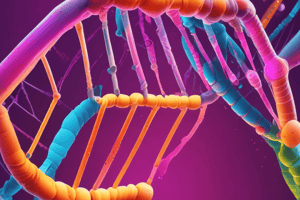Podcast
Questions and Answers
What is the general recommendation to avoid inhibition when re-amplifying PCR products?
What is the general recommendation to avoid inhibition when re-amplifying PCR products?
- Use higher amounts of gDNA template
- Increase the concentration of reaction components
- Skip purification steps for PCR amplicons
- Dilute the reaction in water before the next round of PCR (correct)
How much gDNA template is recommended per 50-µl reaction volume?
How much gDNA template is recommended per 50-µl reaction volume?
- 5-50 ng (correct)
- More than 1000 ng
- 0.1-1 ng
- 100-500 ng
What is the risk associated with using higher amounts of DNA when amplifying PCR targets?
What is the risk associated with using higher amounts of DNA when amplifying PCR targets?
- Enhance specificity
- Increase yield
- Increase nonspecific amplification risk (correct)
- Reduce sensitivity
Why is it important to optimize DNA input when performing PCR?
Why is it important to optimize DNA input when performing PCR?
What type of DNA polymerase would require less input DNA due to higher sensitivity to the template?
What type of DNA polymerase would require less input DNA due to higher sensitivity to the template?
What are the adverse effects of excessively high starting DNA concentrations during PCR?
What are the adverse effects of excessively high starting DNA concentrations during PCR?
Flashcards are hidden until you start studying
Study Notes
PCR Template Requirements
- PCR template can be derived from any DNA source, including genomic DNA (gDNA), complementary DNA (cDNA), and plasmid DNA.
PCR Optimization
- Re-amplification of PCR products can be done to increase target yield, but carryover reaction components can inhibit amplification.
- To avoid inhibition, dilute the reaction in water before the next round of PCR or purify PCR amplicons before re-amplification.
Template Amounts
- Recommended amount of gDNA template is 5-50 ng per 50-µl reaction volume.
- For plasmid PCR targets, use 0.1-1 ng per 50-µl reaction volume.
- Optimal template amounts vary based on the type of DNA polymerase used, with more sensitive polymerases requiring less input DNA.
Importance of Optimization
- Lower template amounts reduce yields.
- Higher template amounts increase the risk of nonspecific amplification.
- Excessively high concentrations of starting DNA (> 500-1000 ng) can inhibit amplification reactions.
Studying That Suits You
Use AI to generate personalized quizzes and flashcards to suit your learning preferences.




